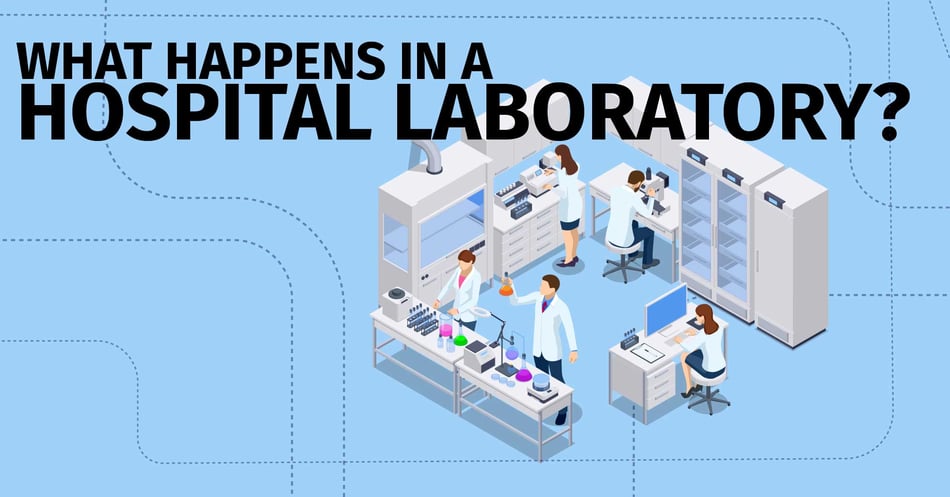What Happens in a Hospital Laboratory?

A critical department of any healthcare facility is the on-site laboratory. Clinical laboratories process the many samples needed to help doctors make diagnoses, create treatment plans, and monitor progress. In fact, up to 70% of diagnoses require laboratory work of some kind. One of the primary testing that takes place in a hospital laboratory is microbiological assays to identify infections, the pathogens that cause them, and their resistance to antibiotics. In today's post, we'll look at the behind-the-scenes activity that makes sure samples are handled safely, tested accurately, and support positive patient outcomes.
First, a quick overview of the types of laboratories in the US health system. There are research laboratories where scientists conduct experiments, either with public funding (like at a university or government laboratory) or private funding (like a pharmaceutical company). There are laboratories that operate independently, processing biological samples for regional doctor's offices (that's where your flu swab it sent) or conducing blood or urine testing for drop-in patients with a doctor's order. Finally, you have hospital laboratories, also called clinical laboratories.
Clinical laboratories are typically housed within the hospital and staffed by the hospital. While they may process samples from local doctor's offices, their primary duties are to process the hundreds of samples collected by doctors at the hospital. These include fluids (blood, urine, spinal, joint, etc.), tissues (skin, tissues, etc.) and swabs (bacterial, viral, fungal, etc.).
How do the samples get to the lab?
If a doctor orders lab work, the collection is made by a nurse or specialist either in the patient's room or in a procedure room (for example, an operating room). All samples are labeled and depending on what kind of sample it is and the time-sensitivity of the test, make their way to the lab. Most hospitals have a pneumatic tube system (much like your drive-through bank tellers) where samples can be sent to the lab automatically. In the case of tissues needing immediate biopsy, many hospitals use a "dumbwaiter" system that allows samples to be placed into a carrier imbedded into the wall and lower it to the lab waiting below. Many samples are still delivered by hand, however, with nurses walking the sample(s) to the laboratory intake counter.
What happens to the sample once it reaches the lab?
All samples are labeled with barcodes that are scanned at every checkpoint, often multiple times along the way to the lab and as it moves through the lab. At arrival, samples marked urgent (STAT, from the Latin statim, meaning "immediately") are moved to the front of the line, but are then sent to the correct laboratory department. Typical departments include hematology (blood), microbiology (pathogens), anatomic pathology (organs) and histology (tissues), each with their own specialists and technicians. Each department will have specialized instruments, as the great majority of tests are automated. Microbiology labs still require hand-plating of samples and visualization of colony forming units. They are also limited by nature, that is, they can't speed up the rate at which bacteria grows!
How are HAIs diagnosed with support from a clinical lab?
One of the key criteria of a hospital-associated infection is that the patient acquired the infection after admission, therefore relying on the clinical laboratory results. If an HAI is suspected, samples will be sent to the lab for confirmation, even if antibiotic treatment is started immediately. In the event of a resistant strain, further testing may be required to identify which antibiotic will be most effective. Sometimes, samples are also sent to government labs which have more advanced equipment but also serve as a central information hub about outbreaks and threats.
What unique threats of infection do clinical laboratories face?
The hospital clinical laboratory can process hundreds of samples per shift, meaning hundreds of opportunities for contamination, but of the sample and of the laboratory. This two-way risk is mitigated by following strict infection control procedures that protect the staff as well as the sample. Routines, checklists, and logistical planning is required to minimize the risk of error, accident, and exposure. Thorough disinfection and use of personal protective equipment is key, but new technologies are providing further safety measures. These include the use of negative air pressure, UV light-treated air, remote-control instrumentation, and biocidal surfaces that self-sanitize continuously.
In a future post, we will look at the specific risks of LAIs, or laboratory-acquired infections as well as steps facilities are taking to better protect their laboratory staff. For now, we hope this introduction into how samples make their way to the lab and provide a critical step in patient care has been informative. What have been your experiences with hospital clinical laboratories? Share your thoughts in the comments below!
![EOScu Logo - Dark - Outlined [07182023]-01](https://blog.eoscu.com/hubfs/Eoscu_June2024/Images/EOScu%20Logo%20-%20Dark%20-%20Outlined%20%5B07182023%5D-01.svg)




